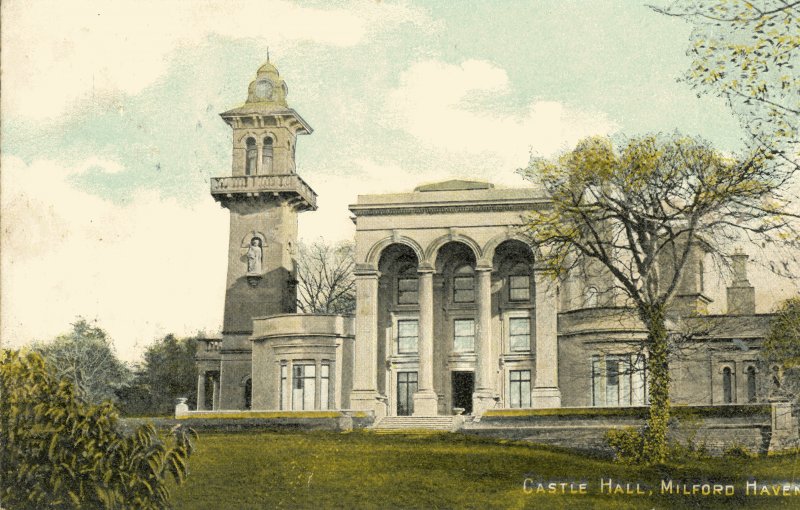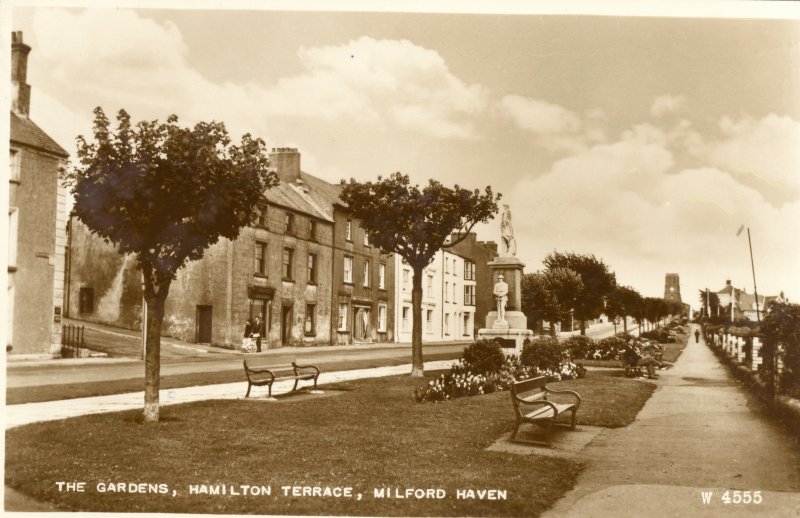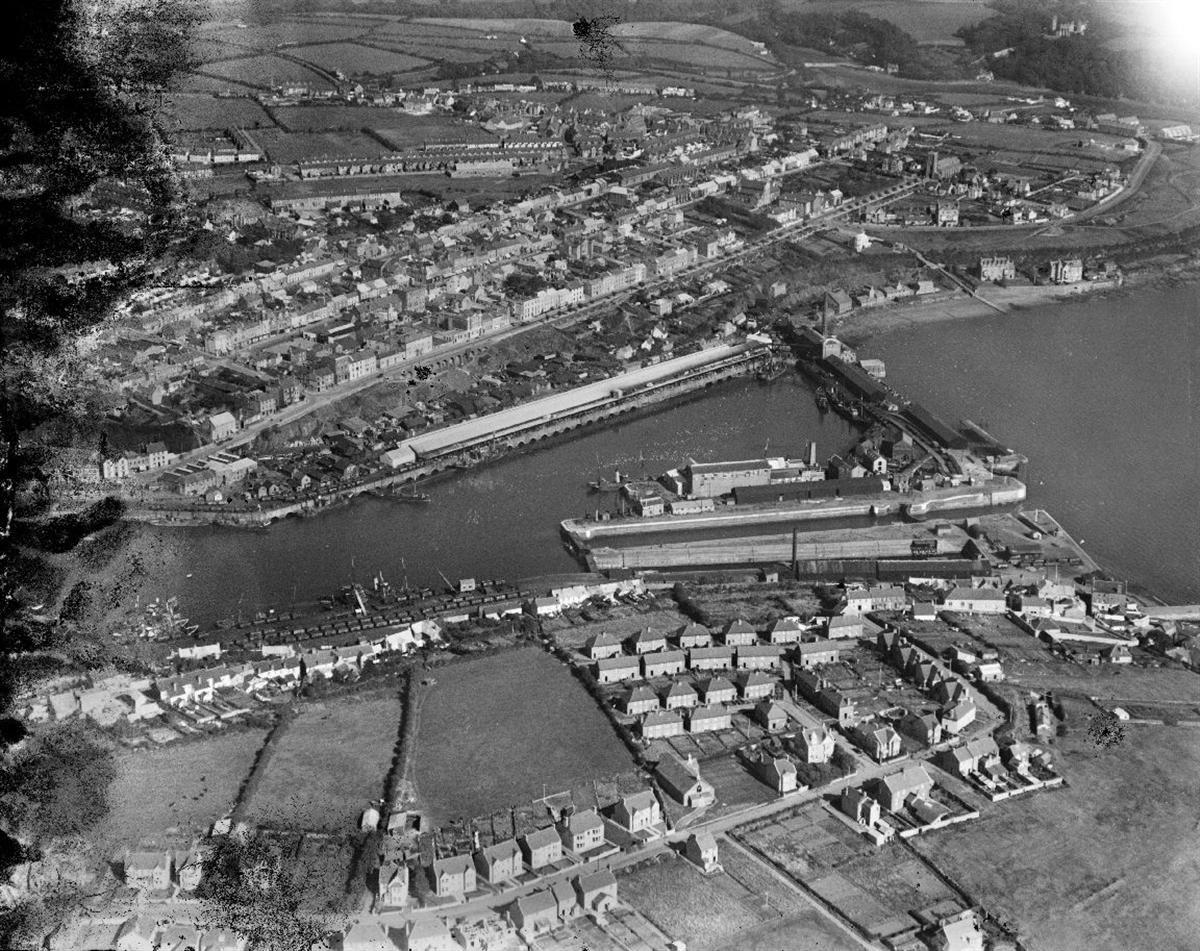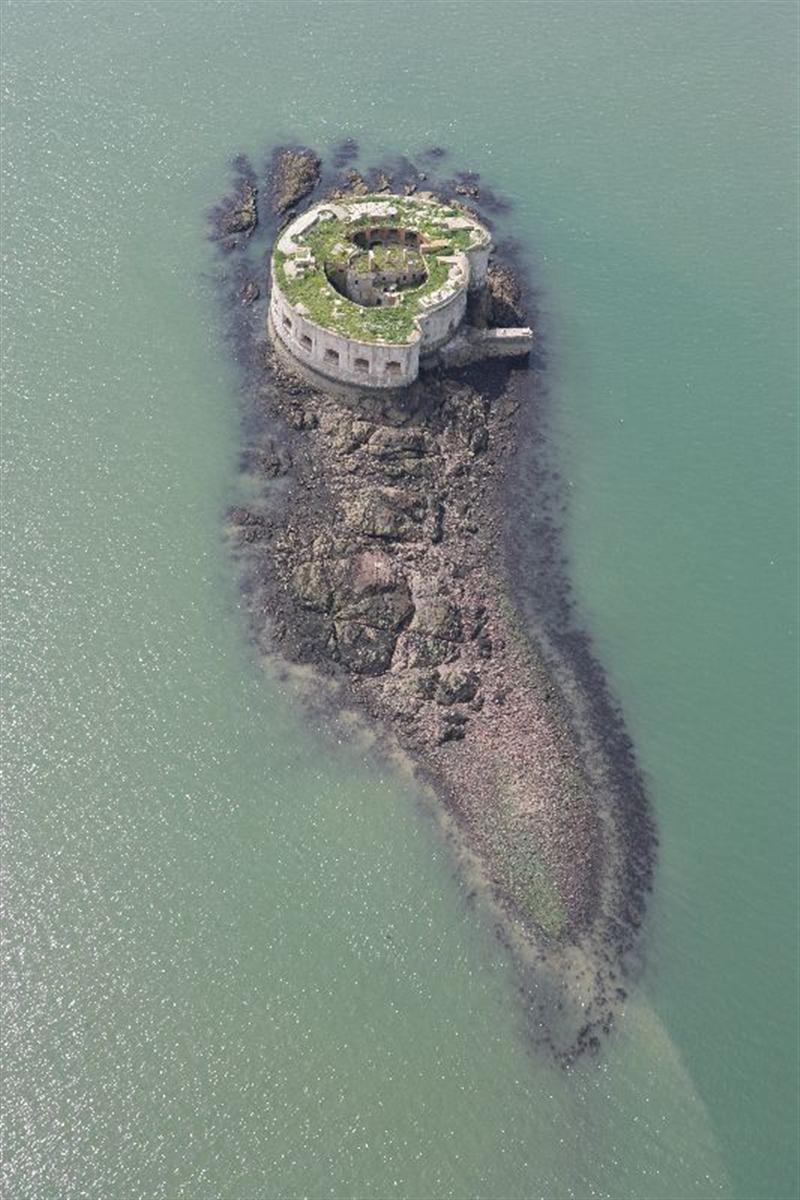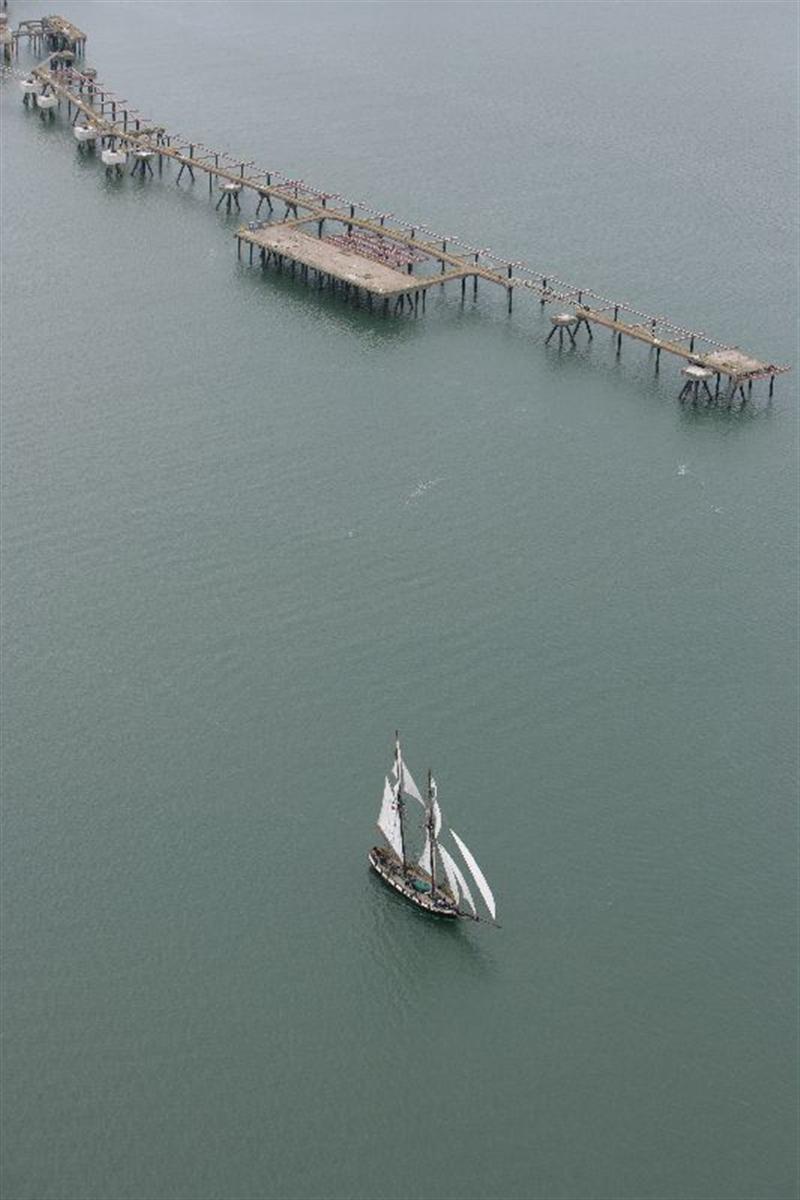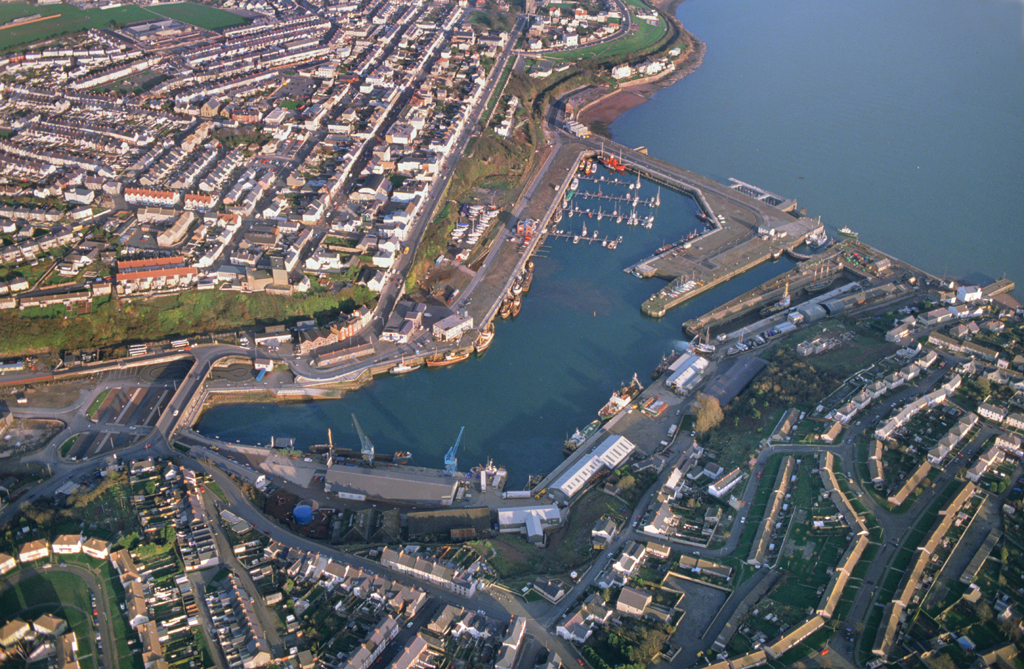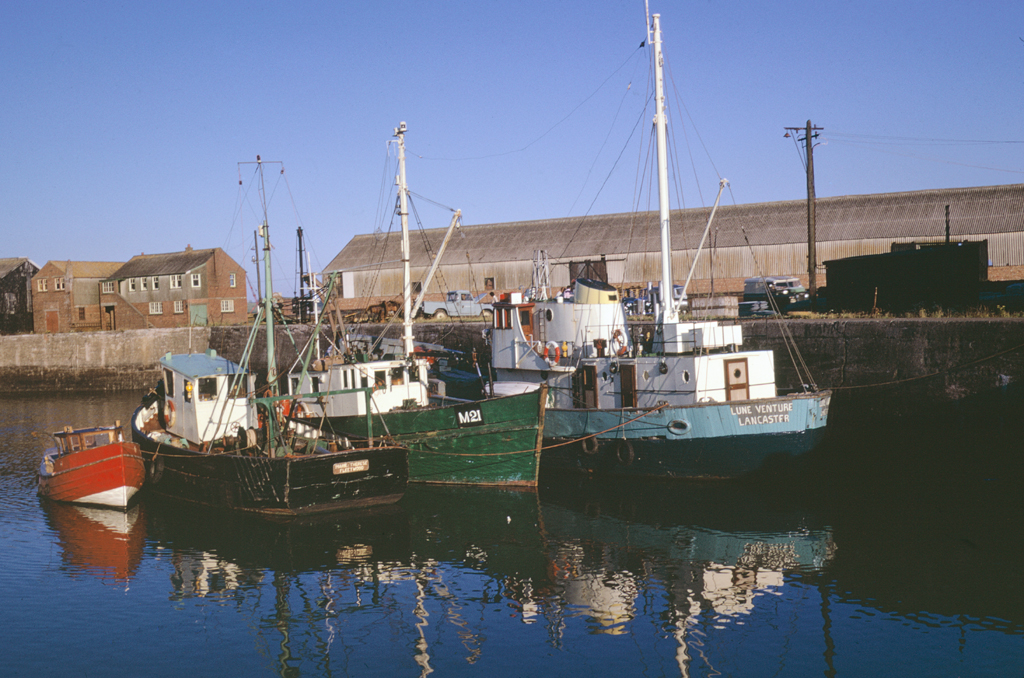Milford Haven - Overview
Milford Haven is a relatively new town which takes its name from the waterway on which it is situated. The natural harbour, which had been in use since the early Medieval period, is most famously associated with the landing of Henry Tudor in 1485 and the launching base for Oliver Cromwell’s 1649 invasion of Ireland. However, the town and built harbour of Milford Haven was only founded in 1790 by William Hamilton, who encouraged whaling families from Nantucket to develop a fleet here. In 1796 a military dockyard for the Royal Navy was developed, but after this moved to Pembroke Dock in 1814, traders took over and re-developed the site into a commercial dockyard.
Despite the town’s historical connection to the Welsh noble families of Pembroke and Tudor, it lies in the area commonly referred to as ‘Little England beyond Wales’. Following the Norman Conquest, Flemings were greatly encouraged to settle here and so replace the Welsh population. Ever since then, the Welsh- and English-speaking communities remain culturally and linguistically distinct.
Owing to its comparatively late foundation and strong ties to commercial seafaring, the town of Milford Haven was not traditionally considered a picturesque travel destination among nineteenth-century tourists. However, the town’s situation on the beautiful Welsh coast, the natural properties of the haven and easy access to the countryside was repeatedly praised by those who landed here. In 1894, Eugenie Rosenberger described how, after one particularly violent storm, Milford Haven experienced a small economic boom. Many crews poured their money into the public houses because their ships had to undergo extensive repairs and they were forced to remain on land for much longer than they had originally planned.
Accounts of Travel
Beyträge zur Kenntniss vorzüglich des Innern von England und seiner Einwohner, 1783
Carl Gottlob Küttner (1755 – 1805)
Als ich den folgenden Morgen wieder aufs Verdeck kam, sah ich die südwestliche Küste von Wallis auf ein paar Meilen vor mir; eine liebliche Aussicht, obschon dieser Theil von Wallis, der nur aus mäßigen Hügeln besteht, bey weitem nicht den angenehmen Anblick gewährt, den die hohen Berge von Nordwallis geben.
Die Einfahrt in den Hafen von Milford hat etwas Großes, das Ehrfurcht einflößt. Ein halb nakter und halb mit Grün bewachsener Fels, steht mitten in dem Eingange des Hafens, so daß auf den beyden Seiten eine Einfahrt ist. Sobald man diesen Felsen im Rücken hat, sieht man den größten Theil dieses ungeheuren Wasserbehältnisses mit allen seinen Bayen, Rheden und Buchten. Dieser herrliche Hafen hat über dreyßig Meilen im Umfange, und könnte, wie man sagt, tausend Schiffe halten und einem jeden hinlänglichen Platz lassen, sich umher zu bewegen. Es ist der größte in Europa, sichert gegen alle Winde, und ist doch blos von der Natur gemacht, folglich kein Hafen für Kriegsschiffe, obschon die ganze englische Flotte auf das bequemste darin liegen könnte. ...
Ich hatte mir einen ganz falschen Begriff von Milfordhaven gemacht; denn ich stellte mir ihn gerade vor, wie einen andern, und erwartete eine Stadt umher. Da aber sein Umfang so groß ist, so läßt es sich leicht denken, daß man an einer Menge Orte ans Land setzen kann, um so mehr, da die Berge oder Hügel umher weder sehr hoch noch steil sind. Unser Hauptmann setzte uns in seinem Boote zu Huberstone aus, welches der gewöhnliche Ort is, wo auch das Paketboot landet. Wir hatten keinen Wind, segelten blos mit der Fluth, und brachten zwey Stunden im Hafen zu, ehe wir heraufkamen.
Das Ganze umher war von der Vormittagssonne beleuchtet, und bietet eine angenehme Aussicht dar. Ich hatte mich vollkommen von der Seekrankheit erholt, die, wie ich nunmehr völlig überzeugt bin, von keiner andern Ursache herkommt, als von der Bewegung des Schiffes; alles andre ist Einbildung. Und so brachte ich die ganze Zeit auf dem Verdecke zu, und beobachtete mit Entzücken alle die verschiedenen Formen, die die Berge umher und die Felsen im Meere durch die verschiedenen Wendungen des Schiffs dem Auge darstellen. Kurz ich habe noch nie eine so angenehme Schiffahrt und so vielen Genuß dabey gehabt. Daß ich hiebey die Geschichte nicht vergaß, können Sie sich vorstellen. Da sahe ich den Grafen von Richmond, wie er mit seiner kleinen Flotte aus Frankreich kommt, zu Milford landet, dann seine Armee in Wallis und Westengland sammelt und den fürchterlichen Richard schlägt.
As I returned to the foredeck on the following morning, I discovered the south-western coast of Wales a few miles ahead of me. It was a sweet prospect, even though this part of Wales, which consists exclusively of moderate hills, does not offer by far the same satisfying sight of the lofty mountains of north Wales.
There is something magnificent in the approach to the harbour at Milford. A rock, half naked and half overgrown with greenery, stands at the centre of the entrance to the harbour, creating a gateway on both sides. As soon as one has passed this rock, one can see the largest part of this vast water basin with all its bays, moorings and inlets. This exquisite harbour is over thirty miles in circumference and could, so they say, hold one thousand ships, but leave enough space for them to navigate freely. It is the largest port in Europe, protected against all winds, but entirely created by nature, wherefore it is no port for warships, although the entire English fleet could easily anchor here. ...
I had formed an entirely false preconception of Milford Haven as I imagined it to be like any other port and so expected a town right by it. As its circumference is so vast, however, one can easily conceive that it is possible to go ashore in many places, especially as the surrounding crags or hills are neither tall nor steep. Our captain set us adrift in his boat near Hubberston, the usual disembarkation place of the packet boat. We had no wind and only sailed with the tide and spent two hours in the harbour before landing.
The entire surroundings were lit by the morning sun and offered a pleasant prospect. I had entirely recovered from my sea sickness, which, I am firmly convinced, has no other cause than the ship’s movement; anything else is mere fancy. And so I spent the entire time on deck and was enamoured by gazing at the diverse forms of the massifs and the rocks in the sea which offer themselves to the eye upon the various turns of the boat. In short, I have never had such a pleasant sea journey and enjoyed it so much. That I was not unaware of history during all this, you can imagine. I pictured the Earl of Richmond arriving at Milford with his small fleet from France, then gathering his army in Wales and the west of England before defeating the dreadful Richard.
Auf großer Fahrt, 1894
Eugenie Rosenberger (1838 – 1931)
Inzwischen habe ich die Ehre, Euch Milfordhaven vorzustellen, denn gestern war Montag und gleich nach dem Frühstück kam das Boot, ich – oder vielmehr der Hund und ich, wurden [von unserem Schiff Regulus] hinuntergelassen; Mohrchen an einem Tau, ich auf einem Brett sitzend und mich festhaltend. Ich sagte schon, daß Milford ein gut geschützter Hafen ist zwischen niedrigen braunroten Felsen; als ich an Land kam, war ich wie in einem englischen Kinderbuch; die Häuser klimperklein; in den Fenstern weißgefalbelte Vorhänge, auf den Tischen zwischen Muscheln, künstlichen Blumen und Raritäten die Bibel mit dem Goldschnitt gegen das Fenster; vor einer Haustür eine alte Frau mit einem großen weißen Hut, die reine Mother Hubbard; die Läden alle ganz klein. Wir kauften wollene Strümpfe und Taschentücher in einem Laden von der gesprächigsten, dicksten alten Dame, der man anmerkte, daß sie gewohnt war, ihr Späßchen mit Seeleuten zu machen und ihnen im „schäkernden Stil“ allerhand aufzuschwatzen. Erst besorgten wir das Geschäftliche beim Broker und beim Konsul, der in einer wahren Höhle haust, und gingen dann über die Felder, an einer Hecke entlang bis der Weg vor einem behaglichen kleinen Landhaus endigte; freuten uns, wieder einen Hahn krähen und Kühe brüllen zu hören, Heu zu riechen und des Lebens überhaupt. Zurückgekehrt, gingen wir zu Herrn Kelway, der alles zu sein scheint, was von Kelway & Sons hier ist, seine Mutter bat uns in ihr kleines Eßzimmer, wo das Feuer im Kamin brannte. Die alte Dame war sehr freundlich, trug eine Witwenhaube, ein schwarzes Kleid und eine große weiße Schürze; an den Wänden hingen Seebilder und Raritäten, da zwei Söhne zur See fahren.
Im Hafen liegen viele Schiffe, aber meist kleine, unter denen der „Regulus“ wie ein „Undeert“ aussieht. Alles ist noch voll von der „Spree“ (spr. Spri), die wegen Havarie hier eingelaufen ist und gedockt hat, – das scheint Milfords große Zeit gewesen zu sein. „All the public-houses went up“ (Alle Gasthäuser nahmen einen Aufschwung), die Frau des Kapitäns hatte sogar hier ein Kleid gekauft und machen lassen. Wohin wir kamen und wen wir auch sprachen, immer hörten wir gleich von der Spri.
In the meantime, I am honoured to introduce you to Milford Haven, because yesterday, Monday morning, the boat arrived right after breakfast and I, or rather, the dog and I were lowered down [from our ship, the Regulus], Mohrchen on a rope and I sitting on a board and holding tight. I mentioned it before that Milford is a well-secured harbour situated between low, puce-coloured rocks. As I disembarked, it felt like stepping into an English children’s book: itty-bitty houses with pleated white curtains in their windows; on tables, gilt-edged Bibles are on display between sea shells, artificial flowers and rarities; like Mother Hubbard, an old woman with a large white hat sits on her doorstep; all the shops are tiny. We bought woollen stockings and handkerchiefs in the shop of the most talkative and rotund lady, who was obviously used to jesting with the sea-faring folk and, with her flirtatious manner, talked them into buying all sorts of things. First we took care of business at the broker and the consul, who lives in an actual cave, before we went into the fields, walking alongside a hedge until the path terminated in front of a cosy little farm house. We were delighted to hear once more the crowing of a cockerel and the lowing of cows, to smell the hay and just enjoy life in general. On our return, we visited Mr Kelway, who appears to be the sole representative of Kelway & Sons in this place. His mother invited us into her small sitting room where the fire was lit. The old lady was very welcoming; she wore a widow’s cap, a black dress and a large white apron. On the walls hung pictures with maritime scenes and some rarities, as two of her sons are sea farers.
Many ships, mostly small ones, are anchored in the harbour, the Regulus between them looking much like a ‘Leviathan’. The Spree – a ship which came here and docked after an accident – is still everything here. It appears to have been Milford’s finest hour. ‘All the public houses went up’ and the captain’s wife even ordered a dress to be made for her here. Wherever we went and with whomever we talked, always they talked about the Spree.
Promenade d’un Français dans l’Irlande, Etc., 1796
Jacques-Louis de Bougrenet de La Tocnaye (1767 – 1823)
Mais j’étais en route pour l’Irlande, et je me rendis à Milford Haven, qui est bien le plus vilain trou, dans lequel voyageur pressé, puisse manger jusqu’à son dernier sou, en attendant le bon vent. Trois ou quatre fois, nous mîmes à la voile et aussi souvent nous fûmes obligés par les vagues de rentrer dans le port, à la quatrième enfin, nous nous arrêtames à Deal, petit village à l’entrée de la baye où nous restâmes huit jours.
Dans le cours ordinaire de choses, oh! comme j’aurais juré et me serais impatienté, en dépit de la belle et large baye et du pays singulier; mais le hazard avait fait prendre place dans le même paquet, à une famille aimable d’Ecosse et à un Irlandais qui avait servi longtemps en France, et je sus si bien prendre mon parti, que je craignais, plutôt que je ne désirais le bon vent. Nous passâmes enfin, et même assez rapidement, car nous joignîmes l’autre côté, dans moins de vingt quatre heures.
Les commis de la douane se sont arrogés un tribut des deux côtés de l’eau sur les passagers et leur demandent un petit écu par tête, pour la permission d’embarquer où de débarquer leurs effets: Un d’eux ayant refusé de la payer, eut son petit sac boulversé d’une manière cruelle. Le prix du passage est exorbitant, une guinée et demie dans la cabine, et le Paquet-Boat, est loin d’être des plus commodes et des plus propres: j’avais pris cette route par économie, et les frais revinrent à plus du double que par Holyhead.
But I was making my way to Ireland, and went to Milford Haven, which has to be the worst dump in which an impatient traveller can his way through all his money, whilst waiting for the right wind. Three or four times we set sail only to be obliged by the waves to return to the port; at the fourth attempt we stopped at Deal, a little village at the entrance to they bay, where we stayed eight days.
Under normal circumstances, oh! how I would have cursed and been impatient, despite the beautiful, wide bay and fascinating countryside; but chance had placed in the same heavy seas a likeable Scottish family and an Irishman who had long served in France, and I got on so well with them that I was dreading rather than wishing for the right wind. At last we crossed, and quite quickly, as we reached the other side in under twenty four hours.
The customs men have taken the liberty of levying a charge on passengers, both sides of the water, asking for a crown per head, for permission to load or unload their luggage. One passenger, on refusing to pay, had his little bag knocked over in a cruel manner. The price of the crossing is exorbitant, a guinea and a half in a cabin, and the Packet Boat is far from being comfortable or clean: I had chosen this route for the sake of economy, but the costs came to more than twice Holyhead.
L’Irlande et le pays de Galles, 1844
Amédée Pichot (1795 – 1877)
C’est à Milford-Haven que, dans la tragédie si romanesque du Cymbeline de Shakespeare, Posthumus, trompé par le perfide Iachimo, donne rendez-vous à Imogène pour la faire périr. Il avait plu dans l’après-midi; mais j’arrivai sur le bord de la mer aux approches de minuit, par un ciel tout parsemé d’étoiles, et la lune éclairait si magnifiquement la baie, qu’il était impossible de ne pas lui appliquer l’exclamation d’Imogène:
Dis-moi comment la Galle est si heureuse
D’avoir pareille baie!
La mer, qui était calme mais scintillante, semblait elle-même mêler ses feux phosphoriques aux lumières du firmament : on eût dit de deux vastes miroirs se reflétant l’un l’autre. Les ténèbres existaient bien autour de cette espèce de lac formé par la baie, mais plutôt comme les ombres transparentes du crépuscule accusant encore les formes des montagnes et les inégalités du rivage, que comme des ténèbres nocturnes. Je n’ai jamais nié, enfant partial du Midi, la beauté spéciale des nuits du Nord, et le spectacle grandiose de l’Océan; cependant, pour rendre justice à cette scène magique de la mer de Milford-Haven, que je renonce à décrire, je ne saurais mieux faire que de la comparer aux plus beaux effets de lune que j’aie vus sous le ciel d’Alger, ou sous ce ciel d’Italie, qui inspira à Byron son apostrophe aux étoiles: « Vous êtes la poésie du firmament ».
It is at Milford Haven that, in Shakespeare’s fantastical tragedy Cymbeline, Posthumus, tricked by the treacherous Iachimo, arranges to send Imogen to her death. It had rained during that afternoon, but I arrived at the seashore near midnight, under a star-studded sky, and the moon lit the bay so magnificently that it was impossible not to apply to it Imogen’s exclamation:
Tell me how Wales was made so happy as
To inherit such a haven!
The sea, calm but sparkling, seemed to be combining its phosphorescent/ shining fires with the lights of the sky: giving the impression of two vast mirrors reflecting each other. Though darkness indeed surrounded this lake, formed by the bay, it was rather in the manner of dusk’s transparent shadows that only accentuate the shapes of the mountains and the unevenness of the shore, than the dark of night. Myself, partly a child of the South, I have never denied the particular beauty of the nights of the North, and the grand spectacle of the Ocean; however, in order to do justice to this magical sea scene at Milford Haven, that I give up on describing, I could not do better than compare it to the most beautiful effects of the moon that I have seen under the skies of Algiers, or those of Italy, which inspired Byron his apostrophe to the stars: ‘You are the poetry of heaven‘.

